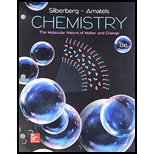
Concept explainers
(a)
Interpretation:
The unit-cell edge length of the densest diamond is to be calculated.
Concept introduction:
Crystal structure or lattice is the three-dimensional representation of atoms and molecules arranged in a particular manner. The unit cell is the smallest part of the lattice that is repeated in all directions to yield the crystal lattice. There are 3 types of cubic unit cells as follows:
1. The simple cubic unit cell
2. Body-centered unit cell
3. Face-centered unit cell
In the cubic unit cell, atom at the corner is shared by 8 adjacent cells so the contribution of an atom at the corner is
(a)
Answer to Problem 12.138P
The unit-cell edge length of the densest diamond is
Explanation of Solution
The formula to calculate the volume of one mole of carbon atom with a higher density is as follows:
Substitute the value of
Diamond has a face-centered cubic unit cell. Face-centered cubic unit cell, 8 atoms are present at the corners of the cell and 6 atoms at the face of the cell. The contribution of an atom present at the corner is
There are 4 atoms at the tetrahedral voids and therefore, the diamond has 8 carbon atoms in the lattice.
The formula to calculate the volume of the unit cell is as follows:
Substitute the value of
The formula to calculate edge length of the cube is as follows:
Substitute the value of
The unit-cell edge length of the densest diamond is
(b)
The number of C atoms present diamond unit cell with the lowest density is to be calculated.
Concept introduction:
Crystal structure or lattice is the three-dimensional representation of atoms and molecules arranged in a particular manner. The unit cell is the smallest part of the lattice that is repeated in all directions to yield the crystal lattice. There are 3 types of cubic unit cells as follows:
1. The simple cubic unit cell
2. Body-centered unit cell
3. Face-centered unit cell
In the cubic unit cell, atom at the corner is shared by 8 adjacent cells so the contribution of an atom at the corner is
(b)
Answer to Problem 12.138P
The number of C atoms present diamond unit cell with the lowest density is
Explanation of Solution
The formula to calculate the volume of one mole of carbon atom with lower density is as follows:
Substitute the value of
The formula to calculate the volume of the unit cell is as follows:
Substitute
The formula to calculate the number of C atoms with lower density is as follows:
Substitute
The number of C atoms present diamond unit cell with the lowest density is
Want to see more full solutions like this?
Chapter 12 Solutions
Loose Leaf for Chemistry: The Molecular Nature of Matter and Change
- For a CARS experiment on a Raman band 918 cm-1, if omega1= 1280 nm, calculate the omega2 in wavelength (nm) and the CARS output in wavelength (nm).arrow_forwardI need help with the following questionarrow_forwardFor CARS, which statement is not true regarding its advantages? a) Contrast signal based on vibrational characteristics, no need for fluorescent tagging. b) Stronger signals than spontaneous Raman. c) Suffers from fluorescence interference, because CARS signal is at high frequency. d) Faster, more efficient imaging for real-time analysis. e) Higher resolution than spontaneous Raman microscopy.arrow_forward
- Draw the major product of the Claisen condensation reaction between two molecules of this ester. Ignore inorganic byproducts. Incorrect, 5 attempts remaining 1. NaOCH3/CH3OH 2. Acidic workup Select to Draw O Incorrect, 5 attempts remaining The total number of carbons in the parent chain is incorrect. Review the reaction conditions including starting materials and/or intermediate structures and recount the number of carbon atoms in the parent chain of your structure. OKarrow_forwardUsing a cell of known pathlength b = 1.25115 x 10-3 cm, a water absorption spectrum was measured. The band at 1645 cm-1, assigned to the O-H bending, showed an absorbance, A, of 1.40. a) Assuming that water density is 1.00 g/mL, calculate the water molar concentration c (hint: M= mole/L) b) Calculate the molar absorptivity, a, of the 1645 cm-1 band c) The transmitted light, I, can be written as I= Ioexp(-xb), where x is the absorption coefficient (sometimes designated as alpha), Io is the input light, and b is the cell pathlength. Prove that x= (ln10)*x*c d) Calculate x for the 1645 cm-1 bandarrow_forwardConvert 1.38 eV into wavelength (nm) and wavenumber (cm-1) (c = 2.998 x 108 m/s; h = 6.626 x 10-34 J*s).arrow_forward
- Can you help me understand the CBC method on metal bridging by looking at this problem?arrow_forwardA partir de Aluminio y Co(NO3)2ꞏ6H2O, indicar las reacciones a realizar para obtener Azul de Thenard (Al2CoO4).arrow_forwardTo obtain Thenard Blue (Al2CoO4), the following reaction is correct (performed in an oven):Al(OH)3 + Co(OH)2 → Al2CoO4 + 4 H2Oarrow_forward
 ChemistryChemistryISBN:9781305957404Author:Steven S. Zumdahl, Susan A. Zumdahl, Donald J. DeCostePublisher:Cengage Learning
ChemistryChemistryISBN:9781305957404Author:Steven S. Zumdahl, Susan A. Zumdahl, Donald J. DeCostePublisher:Cengage Learning ChemistryChemistryISBN:9781259911156Author:Raymond Chang Dr., Jason Overby ProfessorPublisher:McGraw-Hill Education
ChemistryChemistryISBN:9781259911156Author:Raymond Chang Dr., Jason Overby ProfessorPublisher:McGraw-Hill Education Principles of Instrumental AnalysisChemistryISBN:9781305577213Author:Douglas A. Skoog, F. James Holler, Stanley R. CrouchPublisher:Cengage Learning
Principles of Instrumental AnalysisChemistryISBN:9781305577213Author:Douglas A. Skoog, F. James Holler, Stanley R. CrouchPublisher:Cengage Learning Organic ChemistryChemistryISBN:9780078021558Author:Janice Gorzynski Smith Dr.Publisher:McGraw-Hill Education
Organic ChemistryChemistryISBN:9780078021558Author:Janice Gorzynski Smith Dr.Publisher:McGraw-Hill Education Chemistry: Principles and ReactionsChemistryISBN:9781305079373Author:William L. Masterton, Cecile N. HurleyPublisher:Cengage Learning
Chemistry: Principles and ReactionsChemistryISBN:9781305079373Author:William L. Masterton, Cecile N. HurleyPublisher:Cengage Learning Elementary Principles of Chemical Processes, Bind...ChemistryISBN:9781118431221Author:Richard M. Felder, Ronald W. Rousseau, Lisa G. BullardPublisher:WILEY
Elementary Principles of Chemical Processes, Bind...ChemistryISBN:9781118431221Author:Richard M. Felder, Ronald W. Rousseau, Lisa G. BullardPublisher:WILEY





